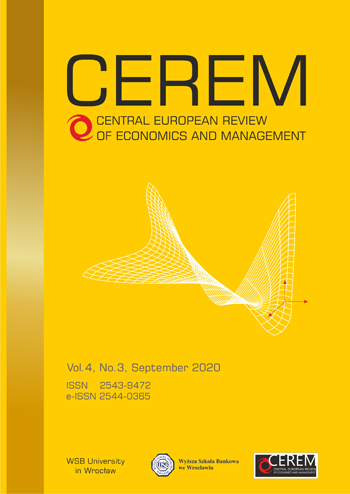Sustainable development from an evolutionary perspective
DOI:
https://doi.org/10.29015/cerem.883Słowa kluczowe:
sustainable development, evolution, environmental economics, politicsAbstrakt
Aim: awareness of the inherent unsustainability of past economic development, the magnitude and multidimensionality of the resulting environmental problems and the urgency of a paradigm shift in politics and economics.
Design / Research methods: reflection on Matthias Glaubrecht´s book “Das Ende der Evolution” (The End of Evolution). Additionally Yuval Harari´s book “Sapiens” and some online sources were used.
Conclusions / findings: An evolutionary developed cognitive superiority has made Homo sapiens not only to the most successful but also the most destructive species ever, which makes a drastic shift towards sustainable development is overdue in the 21st century.
Originality / value of the article: highlighting the slow and merciless mechanisms of evolution and its big cycles, raising more awareness of the vulnerability of mankind and the necessity for a paradigm shift.
Implications of the research (if applicable): urgency of sustainable development in politics, economics and research.
Keywords: sustainable development, evolution, environmental economics, politics
JEL: B52, Q01, Q59
Bibliografia
Biedermann P.H.W., Müller J., Grégoire J.C., Gruppe A., Hagge J., Hammerbacher A., Hofstetter R.W., Kandasamy D., Kolarik M., Kostovcik M., Krokene P., Sallé A., Six D.L., Turrini T., Vanderpool D., Wingfield M.J., Bässler C. (2019), Bark beetle population dynamics in the Anthropocene: challenges and solutions, “Trends in Ecology and Evolution”, vol. 34 no. 10, pp. 914-924, https://doi.org/10.1016/j.tree.2019.06.002.
Brundtland, G.H. (Ed.) (1987), Report of the World Commission on Environment and Development: our common future, Oxford University Press, London.
Darwin Ch. (1859), On the origin of species by means of natural selection or the preservation of favoured races in the struggle for life, John Muray publishers, London.
Glaubrecht, M. (2019), Das Ende des Evolution – Der Mensch und die Vernichtung der Arten (The end of evolution – Man and the annihilation of species), Bertelsmann Verlag, München.
Halliday T.J.D., Upchurch, P., Goswami A. (2016), Eutherians experienced elevated evolutionary rates in the immediate aftermath of the Cretaceous–Palaeogene mass extinction, Dryad, Dataset, https://doi.org/10.5061/dryad.0nr5s.
Harari Y. (2014), Sapiens, A brief history of humankind, HarperCollins, London.
Lieberman, D., Bramble, D. (2007), The evolution of marathon running, “Sports Med”, vol 37 no. 4-5, pp. 288-290,.https://doi.org/10.2165/00007256-200737040-00004.
Lowery Ch., Fraass A (2019), Morphospace expansion paces taxonomic diversification after end Cretaceous mass extinction, “Nature Ecology & Evolution”, vol. 3 no. 6, pp. 900-904, https://doi.org/10.1038/s41559-019-0835-0.
New International Version. Bible Gateway, www.biblegateway.com [04.09.2020].
Zehner O. (2012), Green illusions: The dirty secrets of clean energy and the future of environmentalism, University of Nebraska Press, 2012.
Pobrania
Opublikowane
Numer
Dział
Licencja
Autor przenosi nieodpłatnie na Wyższą Szkołę Bankową we Wrocławiu , bez ograniczeń terytorialnych, majątkowe prawa autorskie do tego utworu w rozumieniu ustawy z dnia 4 lutego 1994 roku o prawie autorskim i prawach pokrewnych ( Dz.U. 1994, Nr 24, poz. 83 ze zm. )na zasadzie wyłączności, tj. prawo do:
a) wyłącznego używania i wykorzystania utworu w dowolnej działalności przez Wyższą Szkołę Bankową we Wrocławiu, w szczególności w działalność Biblioteki Cyfrowej uruchomionej przez Wyższą Szkołę Bankową we Wrocławiu
b) wytwarzania, utrwalania i zwielokrotniania egzemplarzy utworów wszelkimi technikami, w tym techniką drukarską, reprograficzną, zapisu magnetycznego oraz techniką cyfrową, w szczególności ich zwielokrotniania poprzez dokonywanie zapisów na płytach typu CD,
c) zamieszczenia wybranych fragmentów utworu w celach promocyjnych w publikacjach, materiałach promocyjnych, w sieci Internet oraz sieciach wewnętrznych typu Intranet Wyższej Szkoły Bankowej we Wrocławiu,
d) wprowadzania utworu do pamięci komputera Wyższej Szkoły Bankowej we Wrocławiu,
e) kopiowania i powielania utworu w technologiach fotomechanicznych lub innych znanych w dniu zawarcia umowy (fotokopie, kserokopie itp.),
f) przetworzenia dzieła na formę elektroniczną i nieograniczonego rozpowszechniania w sieci Internet.


